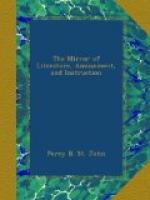quick of sight and hearing; lays two, pale, olive-brown
eggs, with darker spots, in a hole scraped in the
ground. In autumn Bustards are gregarious, when
they leave the open downs for more sheltered situations.
The eggs are eagerly sought after, for the purpose
of hatching under hens: they have been reared
thus in Wiltshire. As they are very valuable
birds, and eagerly sought after, they are scarce.
Mr. Jennings doubts whether they still exist in Wiltshire;
but, from a paper lately read before the Linnaean
Society, by Messrs. Sheppard and Whitear, it appears
that Bustards now breed in the open parts of Suffolk
and Norfolk: they have, too, been domesticated
by Mr. Hardy, of Norwich.[7] Mr. Jennings, in a note
to the lines above quoted, observes, “There
were formerly great flocks of Bustards in this country,
upon the wastes and in woods, where they were hunted
by greyhounds, and easily taken. They have been
latterly recommended to be bred as domestic fowls;
and, to those who desire novelty, the Bustard seems
to be peculiarly an object for propagation. The
flesh is delicious; and it is supposed that good feeding
and domestication might stimulate them to lay more
eggs.” We were aware that the Bustard was
formerly eaten, and remember their mention among the
delicacies of chivalric feasts, and in the bills of
fare at civic banquets: probably, they are on
the Guildhall table at the moment we are writing—on
Lord Mayor’s Day.
[6] Shaw’s Zoolog.
Lectures, vol. i. 1809.
[7] Ornithologia, p. 206.
[Illustration: The Great Bustard.]
Among the other species of Bustards are the Little,
or Field, and the thick-kneed, Stone-curlew, or Norfolk
Plover. There are also some fine species in India,
where they are generally in pairs, but sometimes in
families of four and five: as they do not fly
high, they are sometimes pursued on horseback, and
fired at with pistols. A young hen makes a particularly
fine dish at table: the flesh of the breast is
full of triangular cavities.[8] The Bustard accordingly
bears a high price in the Indian markets: in
some districts it is called the florikan.
[8] Mag. Nat. Hist.
vol. iii. p. 517.
The Bustard is stated to have been known to descend
suddenly from its flight, and from some unknown caprice,
to attack a horse and its rider with great violence;
and with such blind fury as to suffer itself to be
seized by the traveller rather than attempt an escape.
Two instances of this kind are recorded in the Gentleman’s
Magazine of about the year 1807.
* * * *
*
FINE ARTS.
* * * *
*
CROSSES.




